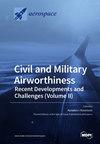Training Sample Pattern Optimization Based on a Swarm Intelligence Algorithm for Tiltrotor Flight Dynamics Model Approximation
IF 2.2
3区 工程技术
Q2 ENGINEERING, AEROSPACE
引用次数: 0
Abstract
Neural networks have been widely used as compensational models for aircraft control designs and as surrogate models for other optimizations. In the case of tiltrotor aircraft, the total number of aircraft states and controls is much greater than that of both traditional fixed-wings and helicopters. This requires, in general, a huge amount of training data for the network to reach a satisfactory approximation precision and makes the network size rise considerably. To solve the practical problem of reducing the size of the approximating network, efforts have to be made in the efficient utilization of the limited amount of training data. This work presents the methodology of optimizing the sample pattern of the training data set by adopting the metaheuristic algorithm of the particle swarm optimizer improved by the fourth-order Runge–Kutta algorithm. A 6-degree-of-freedom nonlinear flight dynamics model of the tiltrotor aircraft is derived, along with its approximation radial basis function neural network. An example case of approximating a highly nonlinear function is studied to illustrate the principle and main parameters of the optimizer, and the approximation performance of the time-domain response of the unstable nonlinear system is revealed by the study of a Van der Pol oscillator. Then, the presented method is applied to the modeled tiltrotor aircraft for its early and late conversion modes. The optimization scheme shows great improvement in both cases, as the function approximation error is reduced significantly.基于蜂群智能算法的训练样本模式优化,用于倾转旋翼机飞行动力学模型逼近
神经网络已被广泛用作飞机控制设计的补偿模型和其他优化的替代模型。就倾转旋翼机而言,飞机状态和控制的总数远远大于传统的固定翼飞机和直升机。这通常需要大量的训练数据才能使网络达到令人满意的近似精度,并使网络规模大幅增加。为了解决缩小近似网络规模的实际问题,必须努力有效利用有限的训练数据。本研究采用粒子群优化器的元启发式算法,通过四阶 Runge-Kutta 算法进行改进,提出了优化训练数据集样本模式的方法。推导出了倾转旋翼机的 6 自由度非线性飞行动力学模型及其近似径向基函数神经网络。研究了一个逼近高度非线性函数的实例,以说明优化器的原理和主要参数,并通过对 Van der Pol 振荡器的研究揭示了不稳定非线性系统时域响应的逼近性能。然后,将所提出的方法应用于倾斜旋翼飞机模型的早期和后期转换模式。在这两种情况下,优化方案都有很大改进,函数近似误差明显减小。
本文章由计算机程序翻译,如有差异,请以英文原文为准。
求助全文
约1分钟内获得全文
求助全文
来源期刊

Aerospace
ENGINEERING, AEROSPACE-
CiteScore
3.40
自引率
23.10%
发文量
661
审稿时长
6 weeks
期刊介绍:
Aerospace is a multidisciplinary science inviting submissions on, but not limited to, the following subject areas: aerodynamics computational fluid dynamics fluid-structure interaction flight mechanics plasmas research instrumentation test facilities environment material science structural analysis thermophysics and heat transfer thermal-structure interaction aeroacoustics optics electromagnetism and radar propulsion power generation and conversion fuels and propellants combustion multidisciplinary design optimization software engineering data analysis signal and image processing artificial intelligence aerospace vehicles'' operation, control and maintenance risk and reliability human factors human-automation interaction airline operations and management air traffic management airport design meteorology space exploration multi-physics interaction.
 求助内容:
求助内容: 应助结果提醒方式:
应助结果提醒方式:


